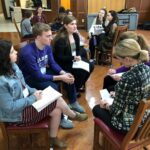In 1969, famed psychologist Stanley Milgram conducted a social experiment looking at the contagiousness of engagement. Wired magazine’s Jonah Lehrer accurately summarizes the experiment:
In this study, Milgram had “confederates” stop on a busy city street and look upwards at the sky. He demonstrated that when one person was looking up, 40 percent of passerby also looked up, just in case something interesting was happening. (There was nothing to look at, just sky and buildings.) When two people were looking up, 60 percent of passerby looked up. When there were three people, the percentage jumped to 65 percent, and, when there were four people, nearly 80 percent of strangers stopped and stared upwards.
Here’s a video of the experiment in action:
In the unrelated setting of the 2009 Sasquatch Music Festival, a replication of Milgram’s experiment occurred as seen in the video below:
The first dancer was alone for a long while but loved every moment. Some would consider him to be a bit socially off. Then #2 shows up, and from his facial expression, seems to look back at his friends as if he were doing it as a dare or joke. Then, #3 shows up and this is where it gets serious. From that moment on, the level of engagement exponentially grows. This is no longer one person dancing, or a dare, or a joke; this is a contagious social movement.
Connecting the ideas together gets me thinking about the role of student leaders on campus. The current paradigm for student leaders is to host engaging activities (e.g. dance parties, cookouts, musicians, etc) and then try to get people to participate. Most schools have a very difficult time achieving success with this model. Also in this model, student leaders tend to look like the sole person dancing by themselves looking a bit off from the rest of the social scene as was the case with the Sasquatch dancer. Yes, you are called a leader for being #1, but the real engagement doesn’t happen until #3 shows up.
In terms of student engagement, maybe student leaders should stop trying to be #1 by hosting the events and instead find the random #1s on your campus and support them by being #3.
Stop creating events that you think are good and look for students on your campus that are doing cool stuff and support them. Stop being the leader and start being the supporter.




